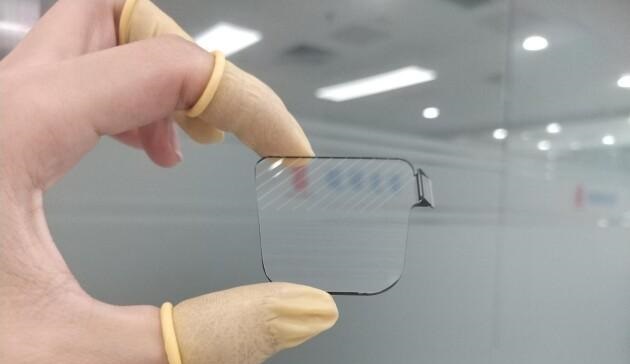The 23rd China International Optoelectronic Expo (CIOE2021) will be held at the Shenzhen International Convention and Exhibition Center on September 16-18, 2021! As a high-tech optoelectronic technology company integrating technology research and development and professional production, SZLJ Optoelectronics Technology Corporation will participate in this optoelectronic expo with the latest two-dimensional expanded pupil array optical waveguide technology module products.
SZLJ's two-dimensional pupil dilated array optical waveguide product adopts the upper right corner coupling form, the module weight is less than 20g, the FOV is as high as 50°, the pupil distance is more than 20mm, the eye movement range is 15x12mm, the distortion is less than 2%, and the transmittance is greater than 85%.

Two-dimensional array optical waveguide-true C-terminal product: high efficiency, positive color
.More uniform color
.Significantly less front light transmission
.Higher contrast ratio: less stray light in the array and more transparent.
.Higher energy utilization: The energy efficiency of the array lightwave waveguide is more than 10 times higher than that of the diffractive waveguide.
…
For a long time, there have been three difficulties in array optical waveguides in the industry: one is that it is difficult to reduce the volume of the coupling part, the other is the problem of light and dark stripes inherent in optical waveguides, and the third is that mass production is more difficult. The process difficulty is an order of magnitude higher.
So, what does SZLJ do in the face of these industry problems?
As one of the few companies in the industry that can achieve mass production and mass shipment of array optical waveguides, as early as March 2018, SZLJ's second-generation 40° optical waveguide products have begun mass production. Up to now, It is in the processing of array optical waveguides. Already have rich experience and advantages, with self-developed design software, self-developed optical parameter detection system, and independent intellectual property system.
In August 2019, SZLJ's newly-built R&D and industrial park was completed, covering an area of 56,400 square meters, further building low-cost, high-quality optical waveguide film and module mass production capabilities, laying the foundation for the full implementation of AR technology. Of course, this also means that the company will have a larger production capacity and the trial and error ability to explore new process research and development paths.
Regarding the two-dimensional array optical waveguide, SZLJ also continuously overcomes the technical problems of the two-dimensional array waveguide, and after continuous technological iterative improvement, the two-dimensional array optical waveguide is produced. It can not only expand the field of view, exit pupil distance, eye movement range, but also ensure high-fidelity image quality; uniformity, color and other performance indicators have reached the domestic leading level; at the same time, the idea of refraction hybrid optical machine is adopted to make optical machine Lighter and thinner, the volume of the coupling part of the product can be reduced. In terms of product parameters and effects, it is already comparable to the products of top foreign manufacturers.
It is worth noting that Longjing Optoelectronics' 60-degree two-dimensional arrayed waveguide will be available soon, bringing a larger FOV, a larger Eyebox, and a better display effect, so stay tuned.
Two-dimensional pupil-expanded array optical waveguide products help consumer AR landing
The array optical waveguide solution mainly uses geometric optics theory, optical design simulation software and high-precision manufacturing process to achieve a high level of image quality.
The two-dimensional pupil dilated array optical waveguide solution can simultaneously achieve vertical and horizontal bidirectional exit pupil expansion, thereby effectively increasing the exit pupil distance and the size of the eyebox, and significantly reducing the volume of the coupled projector. With a small form factor, the angle of view can be increased, giving users an ultimate AR experience.
The two-dimensional pupil expanded array optical waveguide solution also solves the contradiction between the volume of the one-dimensional pupil expanded array optical waveguide and the FOV and EYEBOX.
In the one-dimensional expanded pupil array optical waveguide product, the volume of the optical machine is directly related to the FOV (field of view) of the product. The larger the FOV, the larger the volume of the optical machine, which has certain restrictions. However, under the action of the two-dimensional pupil-expanded optical waveguide technology, the two-dimensional pupil-expanded array optical waveguide product can achieve two-way pupil expansion in the vertical and horizontal directions, and even a small optical machine can achieve a large FOV and a large EYEBOX.
It should be noted that in AR glasses products, in addition to the array optical waveguide solution, the current mainstream solutions also include prisms, Birdbath, free-form surfaces, off-axis holographic lenses, etc. But these schemes are almost all limited by volume, and they also have certain limitations in C-end applications.
In addition to the two-dimensional array optical waveguide technology, diffractive waveguides are also considered to be an optical solution that may solve the C-end mass production products. However, the diffractive waveguide solution also has certain shortcomings. If there is a dispersion problem, it is mainly manifested as the uneven color in the FOV and the eye-moving frame, that is, the "rainbow effect." In addition, since the diffraction element will form multi-order diffraction, the "outside" of the optical waveguide display lens will also show other orders of diffracted energy, showing the phenomenon of "outside light leakage".
Therefore, the two-dimensional array optical waveguide technology is considered to be a better optical solution for consumer-grade AR glasses due to its thin and light appearance and high light transmittance, which is closer to the demand for consumer-grade AR.

